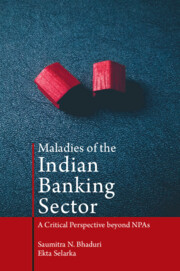Book contents
- Frontmatter
- Dedication
- Contents
- List of Figures
- List of Tables
- Foreword
- Acknowledgements
- 1 Prologue
- 2 The Indian Banking Sector: A Brief History
- 3 The Index of Credit Allocative Efficiency
- 4 Macroeconomic Analyses of Bank Credit Misallocation in the Indian Corporate Sector: Investigation of Pro-cyclicality
- 5 Determinants of Bank Credit Misallocation: Firm-level Analysis
- 6 Allocative Efficiency of Bank Credit and Firm Performance
- 7 Credit Reallocation by Indian Banks in the Aftermath of the Global Financial Crisis
- 8 The Zombie Story: Credit Boom and the Rise of Zombie Firms in the Indian Economy
- 9 Epilogue
- Bibliography
- Index
7 - Credit Reallocation by Indian Banks in the Aftermath of the Global Financial Crisis
Published online by Cambridge University Press: 27 September 2022
- Frontmatter
- Dedication
- Contents
- List of Figures
- List of Tables
- Foreword
- Acknowledgements
- 1 Prologue
- 2 The Indian Banking Sector: A Brief History
- 3 The Index of Credit Allocative Efficiency
- 4 Macroeconomic Analyses of Bank Credit Misallocation in the Indian Corporate Sector: Investigation of Pro-cyclicality
- 5 Determinants of Bank Credit Misallocation: Firm-level Analysis
- 6 Allocative Efficiency of Bank Credit and Firm Performance
- 7 Credit Reallocation by Indian Banks in the Aftermath of the Global Financial Crisis
- 8 The Zombie Story: Credit Boom and the Rise of Zombie Firms in the Indian Economy
- 9 Epilogue
- Bibliography
- Index
Summary
The international economy was greatly impacted by the most severe financial crisis, which started in the United States in September 2008, with the collapse of Lehman Brothers. This marked the beginning of the global financial crisis (GFC) and evolved as the greatest crisis since the Great Depression in the 1930s. The GFC exposed the fundamental weakness of the financial systems, particularly in the banking sectors, across the economies. Amplification of the crisis was observed in terms of both scale and severity, affecting the key macroeconomic indicators and eventually leading one after another country towards recession. As the crisis progressed, the banking sector's fragilities were revealed. While examining the role of financial institutions contributing to the crisis, it became apparent that commercial banks disbursed substantial credit towards temporarily inflated asset values without paying much attention to the creditworthiness of the borrowers (Makin, 2019).
As a consequence of the crisis, the world's potential growth declined to −0.1 per cent in 2008–09, which was estimated to be 2.5 per cent before the crisis period (Felipe and Estrada, 2020). Among other indicators, the world unemployment rate increased from 4.9 per cent to 5.6 per cent from 2008 to 2009; inflation rate fell from 8.9 per cent to 2.9 per cent from 2008 to 2009, and industrial output declined from 18.9 trillion US dollars to 16 trillion US dollars from 2008 to 2009 (World Bank, 2019). Further, after the GFC, economies witnessed a sharp decline in the flow of credit, a fall in gross domestic product (GDP) growth rate, excessive budget deficits, inadequate investment, and sluggish wage growth (Makin, 2019). Though the crisis began in the industrialized countries, the emerging countries, which initially resisted the crisis, were also affected by the movements in the global market. While the developed countries introduced large fiscal stimulus packages by extending domestic and foreign borrowing to boost their economies, the emerging countries faced greater obstacles as the investors pulled out their capital where they perceived the slightest risk resulting in a low value of stocks and devaluation of the currency (International Labour Organization, 2011). As a result, actual growth for the developing and BRICS countries during 2008–09 was marked at 4.4 and 5.7 per cent, respectively, in contrast to the potential growth of 6.2 and 7.4 per cent, respectively, following the GFC (Felipe and Estrada, 2020).
- Type
- Chapter
- Information
- Maladies of the Indian Banking SectorA Critical Perspective beyond NPAs, pp. 137 - 159Publisher: Cambridge University PressPrint publication year: 2022



